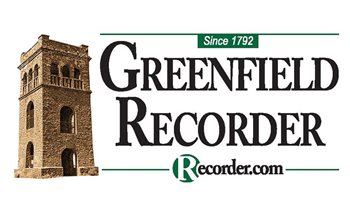Rebirth of Leverett’s Revolutionary-era sawmill: Park, nature trail open as restoration efforts continue
| Published: 06-19-2025 12:18 PM |
LEVERETT — A large banner reading “the Heritage Park and Nature Trail is now open” is placed alongside the red, white and blue bunting attached to the side of the North Leverett Sawmill, a historic pre-Revolutionary War building that awaits renovation and has been declared a critical site for commemorating the nation’s 250th anniversary in 2026.
After several years of planning and then build-out of the 4.6-acre site that includes stone walls and remnants of the historic Graves Ironworks, and a newly constructed wooden deck with benches where visitors can view the river from the start of the trail, a community event at the corner of North Leverett and Cave Hill roads is scheduled for Saturday, June 21, from 1 to 4 p.m.
While the Friends of the North Leverett Sawmill will host the gathering, members of the organization are continuing to plan for what could be up to a $2 million project to complete the restoration of the 81-foot-by-29-foot post-and-beam building and adjacent dam.
“We look forward to sharing this beautiful new resource with our Leverett neighbors and residents of the surrounding community,” said Susan Lynton, treasurer of the nonprofit organization.
Lynton also offered appreciation for the town’s Community Preservation Committee, Greenfield Cooperative Bank and other contributors for making the project possible and setting the stage to transform what had been a working sawmill until the late 1990s into a museum honoring the town’s industrial past, as well as a community arts space and venue for dance, yoga and public events.
Also known as the Slarrow Sawmill, the building is named after Joseph Slarrow, its first owner who was a lieutenant in the Continental Army and later a captain during the Revolutionary War. Both the building and its 2½ acres were given to the organization by the sawmill’s last operators, the Kirley family, in 2022.
Already halfway to raising the money for the restoration, the Friends set a $1.6 million to $1.8 million goal, though $2 million may be needed if dam repairs are included. The project is being supported by a $683,500 grant from the Historic Preservation Fund administered by the National Park Service and a $20,000 grant from Greenfield Cooperative Bank.
Lynton said the federal funding will allow for repairs of windows and doors and landscaping, as well as repairs to the sluice gate and baffles. The main floor, once the primary work area, will become a three-season space, with folding glass window walls on the front side, “which will make it look like it did when in use,” Lynton said. When it was functioning as a sawmill, the large openings were used to get lumber into the sawmill.
Article continues after...
Yesterday's Most Read Articles
 My Turn: A rocky road ahead for Stone Farm Lane proposal
My Turn: A rocky road ahead for Stone Farm Lane proposal
 Mohawk Trail students to see new staff, new codes of conduct upon Aug. 27 return to school
Mohawk Trail students to see new staff, new codes of conduct upon Aug. 27 return to school
 Orange man, 35, dies in crash
Orange man, 35, dies in crash
 Grand opening of Buckland-Shelburne Elementary School playground set for Aug. 26
Grand opening of Buckland-Shelburne Elementary School playground set for Aug. 26
 Bear-y unwelcome: Why MassWildlife says it’s time to ‘break up’ with bird feeders
Bear-y unwelcome: Why MassWildlife says it’s time to ‘break up’ with bird feeders
 Greenfield’s Camelot Cat Cafe opening Friday
Greenfield’s Camelot Cat Cafe opening Friday
The footprint of the long track of the circular saw will also remain. The sawmill had been notable for the length of the carriage and having a log bed that was double the length of others, allowing it to make keels for World War II minesweepers.
The other pieces of equipment from the sawmill days will be displayed along the exterior walls, with temporary movable walls allowing for flexibility and rotating exhibits.
On the lower level, where the owner’s office had been, will be the community space that can be rented. Lynton said this will provide 40% of the necessary operational revenue, with the remaining 60% from endowments and grants.
The nonprofit has applied for a Mass Cultural Facilities grant to build the sanitary system, a raised septic system to mostly handle gray water with composting toilets in three bathrooms. Tentative approval has been given by the Board of Health for this project.
“Structural engineers are in the final stages for determining how to make it a public facility,” Lynton said.
Both the Conservation Commission and Historical Commission will also be reviewing the plans and care is being exercised on site, as there may be remnants on the grounds of the pre-1774 — also known as the Contact Period — arrival of European settlers and their interactions with Native Americans.
A scale model using architectural modeling was created by Steve Stroud, also a member of the Friends, showing walkways that will be compliant with the Americans with Disabilities Act and a small viewing area where visitors can peek into the sawmill around the clock.
The Friends group is hosting the free public event that celebrates the opening of the new site, and visitors will be able to enjoy the park’s riverside pavilion, observe native flora and fauna along the trail, see the industrial ruins and tour the historic sawmill building.
An art exhibit will showcase work by more than 40 artists from the Pioneer Valley, with an emphasis on the sawmill and its surroundings.
The Heritage Park and Nature Trail was conceived by Samuel Black and Cynthia Baldwin, both scientists and retired University of Massachusetts professors who serve on the nonprofit’s board. The half-mile loop trail was supported by $82,082 of the town’s Community Preservation Act funding.
Baldwin said the interpretive signs, each with photos, narratives and QR codes, will help visitors understand the connection between the site’s physical terrain and attributes to the daily lives of the people who lived in and around Leverett, including Native American tribes.
“This place was significant to the Pocumtuck/Sokoki people who inhabited the area at the time of the Contact Period, to the early colonists who established the sawmill, and to the generations of mill owners who operated it during and after New England’s Industrial Revolution,” Baldwin said.
Black credits local tradespeople, consultants and volunteers who contributed their time and skills to the project for its completion.
“Each brought deep expertise in their field and we couldn’t have done it without them,” Black said.
The Friends’ board hopes that, in addition to providing new opportunities for recreation and leisure activities, the park will prompt visitors to reflect on Leverett’s Indigenous history and culture, the ingenuity of the technology and industry that was introduced by colonial settlers, and the importance of native plants and trees to the environment.
For more information, go to leverettsawmill.org.
South Hadley historian Will Melton, a retired executive director of development for the College of Natural Sciences at the University of Massachusetts, is among those studying the history of the Slarrow Sawmill, an interest that developed because his sixth great-grandfather, Dr. Philip Scott, was witness to the building’s 1779 sale.
Melton, who has prepared an article on the sawmill for Historic Deerfield’s research journal this fall, said the building is one of the last authentic sawmills that remain of 200 or so that were operating during the Revolutionary War.
“There are reproductions and replicas, but Slarrow’s Mill is the real thing,” Melton told the Friends of the North Leverett Sawmill at a recent gathering. “I’ve hunted for others in New England for a couple of years and I haven’t found one yet with the pedigree to match Leverett’s.”
The sawmill was established by both Joseph Slarrow and Richard Montague, who became a leader in establishing Leverett as a town separate from Sunderland. Then, after Montague recruited local men to help George Washington drive out the English in Boston, Slarrow organized Leverett’s only militia company and was named its captain.
Through the campaigns of 1777 to 1778, Slarrow and his men responded to alarms at Fort Ticonderoga, the Battle of Saratoga and skirmishes with the British at Warwick, Rhode Island, Melton said.
A year later, Slarrow sold his Leverett farm to Montague and five-eighths of the sawmill.
Scott Merzbach can be reached at smerzbach@gazettenet.com.












 South County Notebook: Aug 17, 2025
South County Notebook: Aug 17, 2025
